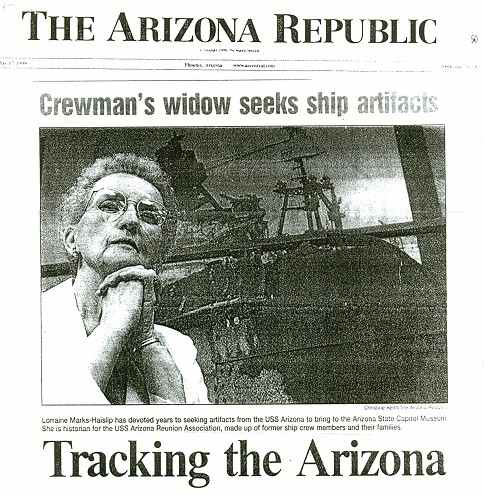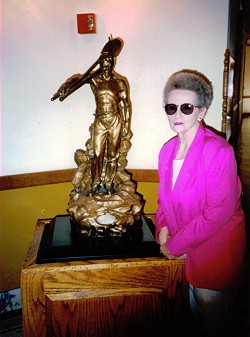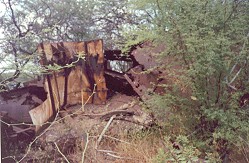
Lorraine Marks-Haislip has devoted years
to seeking artifacts from the USS Arizona to bring to the Arizona State
Capitol Museum.
She is historian [retired] for the USS Arizona Reunion Association, made
up of former ship crew members and their families.
by David Parrish, Arizona Republic

Lorraine Marks-Haislip with
recovered bronze statue. |
When the USS
Arizona sank in 1941 during the attack on Pearl Harbor, a
treasured sculpture of a frontier-era miner was presumed lost.
A Sun City West grandmother found it.
Lorraine Marks-Haislip, a 75-year-old widow of a former
crew member of the ill-fated warship, learned through tireless
research that the sculpture and other long-sought-after
artifacts were packed away and forgotten in a U.S. Navy
warehouse.
In the two yars since the amateur historian made the
discovery, the Arizona State Capitol Museum has been trying to
cut through red tape and have the 40-inch bronze miner returned
to Arizona.
The museum also wants 23 sports trophies and two awards
that once were the pride of the ship's crew.
"The miner definitely belongs to the state, because it was
given to the ship in 1916," Marks-Haislip said.
The sculpture was given to the USS Arizona shortly after
the ship was built to serve as a link between the state and the
ship that bore its name.
During ceremonies, especially in foreign ports, the miner
and the state flag were prominently displayed.
|

Structure now on display Arizona
State Capitol Museum. |
Few have
worked harder or more effectively thank Marks-Haislip to locate
USS Arizona artifacts.
Her deceased husband, Edward Marks, was a USS Arizona crew
member on leave when the ship was sunk. Charles Haislip, her
current husband, served on the ship before transferring to
submarine duty.
After her first husband died in 1986, Marks-Haislip became
the historian for the USS Arizona Reunion Association, made up
of former crew members and their families.
They meet annually around Dec. 7 in Tucson to honor those
who served and died aboard the legendary battleship.
|
"When it came to retirement I couldn't see myself sitting down and
knitting," said Marks-Haislip, who has five daughters, seven
grandchildren, and seven great-grandchildren.
Throughout the years she has uncovered the ship's logs and
manifests, all once thought lost to time or sea.
In 1991 Marks-Haislip followed up a rumor that part of the ship's
superstructure still existed.
She eventually found a section discarded in a jungle of weeds near
Pearl Harbor. A 500-pound section is now on display in the State Capitol
Museum.
Marks-Haislip found the miner sculpture and the trophies through a
combination of persistence and luck.
"The bronze minder had not been seen since before the war," she
said. "Those men who survived the Arizona said they didn't know what
happened to the trophies; they thought they went down with the ship."
Marks-Haislip thought some sports trophies might still exist, so
she visited ports of call where the USS Arizona spent time.
"Oh, I checked in Long Beach, San Francisco and the Puget Sound,"
she said.
While touring a small naval museum in Bremerton, Wash., she asked
the volunteer on duty if she had ever seen a sports trophy from the USS
Arizona.
"She said, 'Yes, we have one of those,'" Marks-Haislip recalled.
For possible leads on the others trophies Marks-Haislip was told to
check with the Naval Historical Center in Washington D.C.
She called there, and an employee combed through the old records,
eventually finding the location where a collection of the sports
trophies were stored.
"He said, 'By the way, I also have something here that seems to
belong to the state of Arizona,'" Marks-Haislip said.
That's how the bronze miner was found.
Just before the USS Arizona sailed to its fate at Pearl Harbor, the
sculpture and the trophies were taken off the ship for safe storage,
Marks-Haislip said.
With the sinking of the ship and the death of most of its officers,
the memory of that transfer was lost.
Marks-Haislip isn't finished trying to track down pieces of the USS
Arizona's history.
She also has found one of the ship's massive deck-gun barrels - 54
feet in length and weighing 63 tons - in a Virginia storage yard. The
barrel has been there since about 1929, when the ship underwent a
refitting.
Michael Carman, State Capitol Museum director, said he has been
calling and writing the Naval Historical Center in Washington, D.C.
imploring officials to permanently loan the miner sculpture and trophies
to the museum.
"I don't think there is any reluctance by the Navy," CArman said.
"We are just not a high priority."
The discovery of the massive deck-gun barrel by Marks-Haislip
presents an entirely different challenge for Carmen.
"The problem is, what do I do with it, how do I get it out here?"
laughed Carman. "She's the type of volunteer that all museum directors
love to have in their corner.
Since the USS Arizona was sunk Dec. 7, 1941, in the suprise attack
that brought the United States into World War II, Arizona has assumed
the role of preserving the battleship's history and honoring the 1, 177
crew members who were killed.
The ship's anchor is on display at the Capitol's Wesley Bolin
Plaza.
The USS Arizona's elaborate silver service set - financed in part
by donations from Arizona children - is displayed in the State Capitol
Museum with other artifacts from the ship.
They are on permanent loan from the Navy, which usually insists on
keeping ownership.
Three years ago the Navy tried to reclaim some of the silver
service for the newly launched USS Tucson, but a local uproar stopped
that effort.
Survivors of the USS Arizona such as Don Stratton of Yuma, said the
bronze miner and trophies belong in Arizona - where they are wanted -
not packed away inside an East Coast warehouse.
"You ask the kids today about Pearl Harbor, and no one knows
anything about it," said Stratton, who suffered burns over 60 percent of
his body escaping the doomed ship. "History gets lost just like these
artifacts, and everybody forgets about it." |
Copyright © 2002-2018 Lorraine Marks-Haislip
|